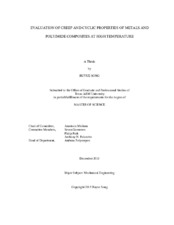| dc.description.abstract | In this study, creep response of metals and polyimide composites at elevated temperatures are analyzed by using empirical models. Empirical models are typically constructed based on experimental observations and their material parameters are calibrated by fitting experimental data. Although empirical models do not provide physical insight into the creep responses of materials, they are practical in structural design applications since they are expressed in simple mathematical functions. Creep responses of Copper alloy NARloy-Z and Titanium alloy Ti-6Al-4V are analyzed in this study by using empirical approach. Deformation-mechanism maps are used to predict their creep behaviors at various stresses and temperatures, and determine the design stresses based on their creep responses. Parametric studies are also conducted to provide the basis for the parameter fitting process. Furthermore, the effect of energy dissipation is incorporated into a phenomenological viscoplastic model to further understand the creep and cyclic responses of NARloy-Z. It is noted that the phenomenological model allows for rigorously incorporating the energy dissipation effect, which is one of the prominent characteristics of time-dependent materials, while the empirical model is limited. From the analyses, it is concluded that the amount of energy dissipation is much more pronounced under cyclic loading, while it is negligible under creep loading. Higher amount of energy dissipation leads to a more pronounced stress softening behavior, which is one of the sources for material failures.
The empirical model and deformation maps are extended to understand creep responses of polyimides and carbon/polyimide fiber composites at elevated temperatures. PMR-15 polyimide is used as an example to illustrate how empirical model is used to predict the creep response. Rule of mixtures is considered to capture the creep response of carbon/polyimide composite. Results showed that empirical models can give reasonable predictions of creep behaviors for alloys, polyimides, and polyimide composites along axial fiber direction. Thus, the model can be used to construct deformation maps and determine design (allowable) stresses for structural design purposes. | en |


